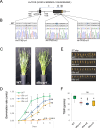TFIIS is required for reproductive development and thermal adaptation in barley
- PMID: 39390135
- PMCID: PMC11467006
- DOI: 10.1007/s00299-024-03345-1
TFIIS is required for reproductive development and thermal adaptation in barley
Abstract
Barley reproductive fitness and efficient heat stress adaptation requires the activity of TFIIS, the elongation cofactor of RNAPII. Regulation of transcriptional machinery and its adaptive role under different stress conditions are studied extensively in the dicot model plant Arabidopsis, but our knowledge on monocot species remains elusive. TFIIS is an RNA polymerase II-associated transcription elongation cofactor. Previously, it was shown that TFIIS ensures efficient transcription elongation that is necessary for heat stress survival in A. thaliana. However, the function of TFIIS has not been analysed in monocots. In the present work, we have generated and studied independent tfIIs-crispr-mutant barley lines. We show that TFIIS is needed for reproductive development and heat stress survival in barley. The molecular basis of HS-sensitivity of tfIIs mutants is the retarded expression of heat stress protein transcripts, which leads to late accumulation of HSP chaperones, enhanced proteotoxicity and ultimately to lethality. We also show that TFIIS is transcriptionally regulated in response to heat, supporting a conserved adaptive function of these control elements for plant thermal adaptation. In sum, our results are a step forward for the better understanding of transcriptional machinery regulation in monocot crops.
Keywords: Barley (Hordeum vulgare L.); Heat stress; Reproductive development; TFIIS; Transcriptional elongation.
© 2024. The Author(s).
Conflict of interest statement
All the authors declare that they have no conflict of interest.
Figures



Similar articles
-
Elongation factor TFIIS is essential for heat stress adaptation in plants.Nucleic Acids Res. 2022 Feb 28;50(4):1927-1950. doi: 10.1093/nar/gkac020. Nucleic Acids Res. 2022. PMID: 35100405 Free PMC article.
-
TFIIS Is Crucial During Early Transcript Elongation for Transcriptional Reprogramming in Response to Heat Stress.J Mol Biol. 2023 Jan 30;435(2):167917. doi: 10.1016/j.jmb.2022.167917. Epub 2022 Dec 9. J Mol Biol. 2023. PMID: 36502880
-
The role of RNA polymerase II transcript elongation factors in plant stress responses.J Exp Bot. 2025 Jun 17;76(9):2447-2454. doi: 10.1093/jxb/erae472. J Exp Bot. 2025. PMID: 39626103 Review.
-
Genome-wide identification and expression analysis of Hsp70, Hsp90, and Hsp100 heat shock protein genes in barley under stress conditions and reproductive development.Funct Integr Genomics. 2019 Nov;19(6):1007-1022. doi: 10.1007/s10142-019-00695-y. Epub 2019 Jun 27. Funct Integr Genomics. 2019. PMID: 31359217
-
Prospects of engineering thermotolerance in crops through modulation of heat stress transcription factor and heat shock protein networks.Plant Cell Environ. 2015 Sep;38(9):1881-95. doi: 10.1111/pce.12396. Epub 2014 Aug 6. Plant Cell Environ. 2015. PMID: 24995670 Review.
References
-
- Aoi Y, Shilatifard A (2023) Transcriptional elongation control in developmental gene expression, aging, and disease. Mol Cell 83:3972–3999 - PubMed
-
- Ashikawa I, Abe F, Nakamura S (2013) DOG1-like genes in cereals: investigation of their function by means of ectopic expression in Arabidopsis. Plant Sci 208:1–9 - PubMed
MeSH terms
Substances
Grants and funding
LinkOut - more resources
Full Text Sources

